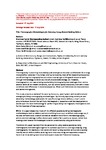Thermography methodologies for detecting energy related building defects
| dc.contributor.author | Fox, Matthew | |
| dc.contributor.author | Coley, D | |
| dc.contributor.author | Goodhew, Steve | |
| dc.contributor.author | de Wilde, Pieter | |
| dc.date.accessioned | 2017-04-19T11:22:11Z | |
| dc.date.available | 2017-04-19T11:22:11Z | |
| dc.date.issued | 2014-12 | |
| dc.identifier.issn | 1364-0321 | |
| dc.identifier.uri | http://hdl.handle.net/10026.1/9088 | |
| dc.description.abstract |
Thermography is becoming more widely used amongst construction professionals for energy related defect detection in buildings. Until quite recently, most of the research and practical use of building thermography has centred on employing a building walk-around or walk-through methodology to detect sources of unacceptable energy use. However, thermographers are now creating new building thermography methodologies that seek to address some of the known limitations, such as camera spatial resolution, transient climatic conditions and differences in material properties. Often such limitations are misunderstood and sometimes ignored. This study presents a review of the existing literature, covering both well-established and emerging building thermography methodologies. By critically appraising techniques and observing methodology applications for specific energy related defects, a much clearer picture has been formed that will help thermographic researchers and thermographers to decide upon the best methodology for performing building thermography investigations and for the invention of new approaches. Whilst this paper shows that many of the different passive building thermography methodologies seek to address particular building issues such as defects and energy use, it has also demonstrated a lack of correlation between the different methodology types, where one methodology is often chosen over another for a particular reason, rather than making use of several methodologies to better understand building performance. Therefore this paper has identified the potential for using several passive building thermography methodologies together in a phased approach to building surveying using thermography. For example, a less costly and faster survey could be conducted to quickly identify certain defects before enabling more time consuming and expensive surveys to hone in on these with greater detail and spatial resolution if deemed necessary. © 2014 Elsevier Ltd. | |
| dc.format.extent | 296-310 | |
| dc.language | en | |
| dc.language.iso | en | |
| dc.publisher | Elsevier BV | |
| dc.subject | Passive building thermography | |
| dc.subject | Thermographic methodologies | |
| dc.subject | Defect detection | |
| dc.title | Thermography methodologies for detecting energy related building defects | |
| dc.type | journal-article | |
| dc.type | Review | |
| dc.type | Journal | |
| plymouth.author-url | https://www.webofscience.com/api/gateway?GWVersion=2&SrcApp=PARTNER_APP&SrcAuth=LinksAMR&KeyUT=WOS:000345473600025&DestLinkType=FullRecord&DestApp=ALL_WOS&UsrCustomerID=11bb513d99f797142bcfeffcc58ea008 | |
| plymouth.volume | 40 | |
| plymouth.publication-status | Published | |
| plymouth.journal | Renewable and Sustainable Energy Reviews | |
| dc.identifier.doi | 10.1016/j.rser.2014.07.188 | |
| plymouth.organisational-group | /Plymouth | |
| plymouth.organisational-group | /Plymouth/Faculty of Arts, Humanities and Business | |
| plymouth.organisational-group | /Plymouth/Faculty of Arts, Humanities and Business/School of Art, Design and Architecture | |
| plymouth.organisational-group | /Plymouth/REF 2021 Researchers by UoA | |
| plymouth.organisational-group | /Plymouth/REF 2021 Researchers by UoA/UoA13 Architecture, Built Environment and Planning | |
| plymouth.organisational-group | /Plymouth/Users by role | |
| plymouth.organisational-group | /Plymouth/Users by role/Academics | |
| dc.rights.embargodate | 2016-12-01 | |
| dc.rights.embargoperiod | 24 months | |
| rioxxterms.versionofrecord | 10.1016/j.rser.2014.07.188 | |
| rioxxterms.licenseref.uri | http://www.rioxx.net/licenses/under-embargo-all-rights-reserved | |
| rioxxterms.type | Journal Article/Review |


